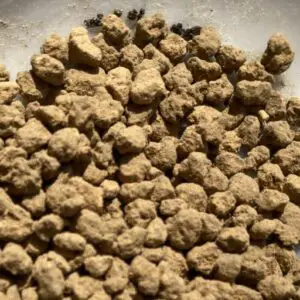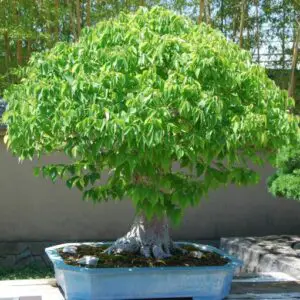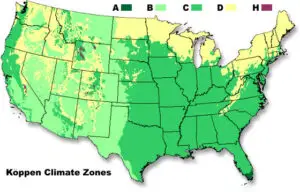How often should you water your bonsai tree
General rule of watering a bonsai tree
Under a temperate climate, you should water your bonsai tree planted in a bonsai pot;
- once a day in spring and fall,
- twice a day in summer, and,
- once every three days in winter.
But this general rule should be altered depending on several factors such as soil in which your bonsai tree is planted, climate/weather of your region and tree species and its growth stage. You need to observe your bonsai tree carefully and water them when the soil is half dry.
Factors affecting bonsai tree water needs
There are three major factors that affect a bonsai tree’s water needs.
- Soil,
- Climate/weather and
- Bonsai species and growth stage.
Soil
Soil factors in bonsai trees’ watering needs can be subdivided into (i) soil’s water-holding capacity and (ii) the amount of soil in the pot.
Water-holding capacity
A soil’s water-holding capacity depends mainly on its texture, i.e. relative proportions of sand, silt, and clay in soil. Clay soil can hold more water than sandy one, so clay soil is better in the water-holding aspect. On the other hand, plants are able to extract more water from sand than clay because clay particles hold water so tightly to the particle surface that plant roots are unable to extract it from the soil.
Ideal bonsai soil has a good water-holding capacity but it also requires good drainage and aeration. The balance between these three is important. But in general, bonsai soil needs smaller amounts of more frequent watering than ordinary houseplant soil mix.
Major types of bonsai soil and water-holding capacity
| Water holding Capacity |
Drainage | Aeration | |
| Akadama | High | High | High |
| Volcanic soil / lava rock | Mid-Low | High | High |
| River sand | Mid-Low | High | High |
| Pumice | Low | High | High |
| Perlite | Mid | High | High |
| Vermiculite | High | High | High |
Amount of soil
Soil depth is another important factor. Shallow soils as in bonsai pots will require lighter and more frequent waterings than usual because there is not much soil to hold water in the first place. Also, very compacted soils after a few years of repotting cannot hold water well so it also requires more watering.
Climate/weather
Major climate/weather factors
Major climate/weather factors that affect watering frequencies are;
- Sunlight,
- Temperature,
- Humidity and
- Wind.
Sunlight: Bonsai trees use more water on sunny days than on cloudy days. Uncovered soil will lose more water than moss-covered soil on sunny days.
Temperature: Bonsai trees use more water on hot days. Also, evaporation losses from the soil surface are also higher.
Humidity: Water use by bonsai trees increases as humidity decreases; the same is true with evaporation.
Wind: Windy weather increases bonsai trees’ water usage as well as evaporation losses.
Bonsai trees’ water needs matrix
The highest water needs for a bonsai tree are found in areas that are sunny, hot, dry, and windy. The lowest is found when it is cloudy, cool, and humid with little or no wind.
| Water needs High |
Water needs Low |
Weather factor |
| Sunny | Cloudy | Sunlight |
| Hot | Cool | Temperature |
| Dry | Humid | Humidity |
| Windy | No wind | Wind |
From the table above, it is clear that a bonsai tree grown in different climatic zones will have different water needs.
The table below shows the average water need of standard grass during the irrigation season (desert climate zone with the high temperature being 100%).
Average water need of standard grass during irrigation season (%)
| Mean daily temperature | |||
| Low >59°F or 15°C |
Medium 59-77°F or 15-25°C |
High <77°F or 25°C |
|
| Desert/arid | 53% | 79% | 100% |
| Semi-arid | 47 | 68 | 89 |
| Sub-humid | 37 | 58 | 79 |
| Humid | 17 | 37 | 58 |
(Source: Crop water needs, FAO)
In the desert zone at low temperatures, water need is around half (53%) compared to high temperature (100%). But in the humid zone at low temperatures, on the other hand, water need is less than a third (17%) compared to high temperature under the same climate (58%).
This shows that the humidity level is a key factor, besides temperature, that affects bonsai trees’ water needs.
US climate zones and watering
There are 5 major climate zones in the mainland US;
- tropical,
- dry,
- moist subtropical mid-latitude,
- moist continental mid-latitude and
- highlands climates.
(Source: National Weather Service)
1- Zone A (Tropical Climates)
Under tropical moist climates, all months have average temperatures greater than 64°F (18°C) and annual precipitation greater than 59″.
- Southern part of Florida
2- Zone B (Dry Climates)
In this climate, plants’ potential evaporation and transpiration exceed precipitation, meaning bonsai trees cannot survive without constant and sufficient watering.
- Arizona
- Nevada
- Texas (small portions in the west)
- California
3- Zone C (Moist Subtropical Mid-Latitude Climates)
This climate generally has warm and humid summers with mild winters. During the winter, the main weather feature is the mid-latitude cyclone. Thunderstorms dominate the summer months.
If kept outside, bonsai trees might not need frequent watering in these climates because of high humidity and precipitations.
- Florida
- Georgia
- Texas
4- Zone D (Moist Continental Mid-Latitude Climates)
This climate has warm to cool summers and cold winters. The average temperature of the warmest month is greater than 50°F (10°C), while the coldest month is less than -22°F (-30°C). Winters are severe with snowstorms and strong winds.
Bonsai trees might not need as much watering as in warmer regions.
- New York
- Pennsylvania
- Michigan
- Illinois
- Oregon (coastal areas)
- Washington (coastal areas)
- California (northern coastal regions)
5- Zone H (Highlands)
Highland climates occur in mountainous terrain where rapid elevation changes cause rapid climatic changes over short distances.
Bonsai species and its growth stage
Bonsai species
Among bonsai species, coniferous trees are the most drought-tolerant in general.
In general, flowering and fruit bonsai species do not have good drought tolerance, and both yield (number of flowers/fruit) and quality can be severely affected by moisture stress. Also, deciduous trees have more leaves with much larger surface areas than coniferous trees, making them more prone to water shortage on sunny days or during summer.
Bonsai tree species and water needs
Drought-tolerant
Pine species (such as black/white/red pine), Hinoki cypress
Slightly drought-tolerant
Persimmon, Chinese dade
Slightly drought-tolerant to moderate
Gardenia, camellia,
Moderate
Ginkgo, maple, beech
Slightly water-loving
Japanese maple, cherry blossom, Japanese plum, Satsuki azalea, azalea, wild rose, cotoneaster, Japanese boxthorn, Chinese quince, Shimpaku juniper, needle juniper
Water-loving
Oak (Quercus dentata, Quercus serrata), birch, wisteria, Ezo spruce
Seasonality
There is a seasonality factor too. Bonsai trees need more water during spring, summer and fall than in winter. Except for evergreens, they are dormant during winter and do not require much water.
For the flowering/fruit bonsai trees, their water needs start to increase from spring and reach a peak around flowering and/or fruiting time.
Growth stage
Bonsai trees’ growth stage affects their water needs as well. A younger tree needs more water to grow than the mature one.
—–
Reference
Peace Corp., “Soil, crops and fertilizer use“, New Zealand Digital Library.






